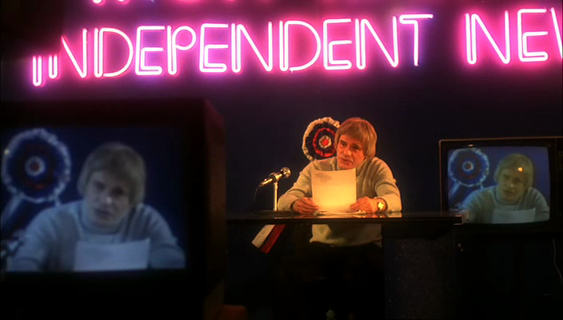 Set a few years before the new Millennium, The War of the World: Next Century is about Iron Idem, a TV reporter who breaks the news that a Martian race had begun to invade earth. Shortly after, Iron loses control of his television program, and is given a script informing him on what to tell the mass populace about the alien invaders. After it becomes clear to Iron that the Martians and government are taking advantage of the general populace, his wife is kidnapped and his ability to report the news is taken from him as well. What ensues is Idem's attempt to fight back against the regime and broadcast the truth to the people about the alien invaders. Piotr Szulkin's The War of the World: Next Century is quite similar to his other films in that Piotr blends science fiction and social commentary, in this case creating a cautionary tale about the powers of mass media and how it manipulates the general public. The Martians appear to be friendly yet there demands continually escalate, wanting more and more from humans. In the film we never see the Martians doing this, rather the police and government, who are imposing this Martian rule. The martians in the film are really irrelevant, as the film is simply making a point about a system of institutionalized oppression and how easily it can all take place when the common people simply do nothing, believing what they are told. The film makes a point about how important independent thought truly is, showing how easily it can be stripped away with a group mentality. Being made on what I'm sure was a small budget, for a science fiction film,the film uses some creative cinematography and ingenuity to create this sci-fi landscape. The film does so much from a visual standpoint, with the compositions and framing constantly driving the story forward, emotionally giving the viewer additional insight into Iron Idem, our main protagonist's struggle. Even more so than the beautiful compositions, the lighting in The War of the World: Next Century is expressionistic and vivid. Szulkin uses an abundance of high contrasting colors and lighting to create this stark, vivid world that visually is simply magnificent. It's only fitting that Piotr Szulkin's film begins with a tribute to Orson Welles, as much of the ideals of the film can be linked to Welles initial radio broadcast, but Szulkin has created a Science Fiction opus that stands right with Godard's Alphaville or Fassbender's World on A Wire, even arguable surpassing them. 9.5/10
2 Comments
10/18/2013 12:41:44 pm
Great site, i've been thinking about getting a free blog from weebly, do you recommend it?
Reply
Eric
10/18/2013 03:02:29 pm
Yes, I would
Reply
Leave a Reply. |
AuthorLove of all things cinema brought me here. Archives
June 2023
|
 RSS Feed
RSS Feed
